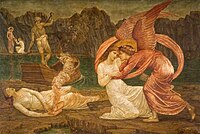Cupid and Psyche
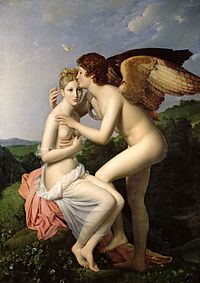
| Part of a series on the |
| Greek underworld |
|---|
| Residents |
| Geography |
| Prisoners |
| Visitors |
Cupid and Psyche is a story originally from Metamorphoses (also called
The story of Cupid and Psyche was known to Boccaccio in c. 1370, but the editio princeps dates to 1469. Ever since, the reception of Cupid and Psyche in the classical tradition has been extensive. The story has been retold in poetry, drama, and opera, and depicted widely in painting, sculpture, and even wallpaper.[5] Though Psyche is usually referred to in Roman mythology by her Greek name, her Roman name through direct translation is Anima.
In Apuleius
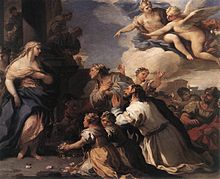
The tale of Cupid and Psyche (or "Eros and Psyche") is placed at the midpoint of Apuleius's novel, and occupies about a fifth of its total length.[6] The novel itself is a first-person narrative by the protagonist Lucius. Transformed into a donkey by magic gone wrong, Lucius undergoes various trials and adventures, and finally regains human form by eating roses sacred to Isis. Psyche's story has some similarities, including the theme of dangerous curiosity, punishments and tests, and redemption through divine favor.[7]
As a structural mirror of the overarching plot, the tale is an example of mise en abyme. It occurs within a complex narrative frame, with Lucius recounting the tale as it in turn was told by an old woman to Charite, a bride kidnapped by pirates on her wedding day and held captive in a cave.[6] The happy ending for Psyche is supposed to assuage Charite's fear of rape, in one of several instances of Apuleius's irony.[8][9]
Although the tale resists explication as a strict
Story
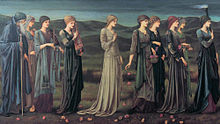
There were once a king and queen,[11] rulers of an unnamed city, who had three daughters of conspicuous beauty. The youngest and most beautiful was Psyche, whose admirers, neglecting the proper worship of Aphrodite (love goddess Venus), instead prayed and made offerings to her. It was rumored that she was the second coming of Venus, or the daughter of Venus from an unseemly union between the goddess and a mortal. Venus is offended, and commissions Cupid to work her revenge. Cupid is sent to shoot Psyche with an arrow so that she may fall in love with something hideous. He instead scratches himself with his own dart, which makes any living thing fall in love with the first thing it sees. Consequently, he falls deeply in love with Psyche and disobeys his mother's order.
Although her two humanly beautiful sisters have married, the idolized Psyche has yet to find love. Her father suspects that they have incurred the wrath of the gods, and consults the
Psyche is arrayed in funeral attire, conveyed by a procession to the peak of a rocky crag, and exposed. Marriage and death are merged into a single rite of passage, a "transition to the unknown".[12] Zephyrus the West Wind bears her up to meet her fated match, and deposits her in a lovely meadow (locus amoenus), where she promptly falls asleep.
The transported girl awakes to find herself at the edge of a cultivated grove (
Although fearful and without the proper experience, she allows herself to be guided to a bedroom where, in the darkness, a being she cannot see has sex with her. She gradually learns to look forward to his visits, though he always departs before sunrise and forbids her to look upon him. Soon, she becomes pregnant.
Violation of trust
Psyche's family longs for news of her, and after much cajoling, Cupid, still unknown to his bride, permits Zephyr to carry her sisters up for a visit. When they see the splendor in which Psyche lives, they become envious, and undermine her happiness by prodding her to uncover her husband's true identity, since surely as foretold by the oracle she was lying with the vile winged serpent, who would devour her and her child.

One night after Cupid falls asleep, Psyche carries out the plan her sisters devised: she brings out a dagger and a lamp she had hidden in the room, in order to see and kill the monster. But when the light instead reveals the most beautiful creature she has ever seen, she is so startled that she wounds herself on one of the arrows in Cupid's cast-aside quiver. Struck with a feverish passion, she spills hot oil from the lamp and wakes him. He flees, and though she tries to pursue, he flies away and leaves her on the bank of a river.
There she is discovered by the wilderness god

Psyche visits first one sister, then the other; both are seized with renewed envy upon learning the identity of Psyche's secret husband. Each sister attempts to offer herself as a replacement by climbing the rocky crag and casting herself upon Zephyr for conveyance, but instead is allowed to fall to a brutal death.
Wanderings and trials
In the course of her wanderings, Psyche comes upon a temple of Ceres, and inside finds a disorder of grain offerings, garlands, and agricultural implements. Recognizing that the proper cultivation of the gods should not be neglected, she puts everything in good order, prompting a theophany of Ceres herself. Although Psyche prays for her aid, and Ceres acknowledges that she deserves it, the goddess is prohibited from helping her against a fellow goddess. A similar incident occurs at a temple of Juno. Psyche realizes that she must serve Venus herself.
Venus revels in having the girl under her power, and turns Psyche over to her two handmaids, Worry and Sadness, to be whipped and tortured. Venus tears her clothes and bashes her head into the ground, and mocks her for conceiving a child in a sham marriage. The goddess then throws before her a great mass of mixed wheat, barley, poppyseed, chickpeas, lentils, and beans, demanding that she sort them into separate heaps by dawn. But when Venus withdraws to attend a wedding feast, a kind ant takes pity on Psyche, and assembles a fleet of insects to accomplish the task. Venus is furious when she returns drunk from the feast, and only tosses Psyche a crust of bread. At this point in the story, it is revealed that Cupid is also in the house of Venus, languishing from his injury.
At dawn, Venus sets a second task for Psyche. She is to cross a river and fetch golden wool from violent sheep who graze on the other side. These sheep are elsewhere identified as belonging to Helios.[14] Psyche's only intention is to drown herself on the way, but instead she is saved by instructions from a divinely inspired reed, of the type used to make musical instruments, and gathers the wool caught on briers.
For Psyche's third task, she is given a crystal vessel in which to collect the black water spewed by the source of the rivers Styx and Cocytus. Climbing the cliff from which it issues, she is daunted by the foreboding air of the place and dragons slithering through the rocks, and falls into despair. Jupiter himself takes pity on her, and sends his eagle to battle the dragons and retrieve the water for her.
Psyche and the underworld
The last trial Venus imposes on Psyche is a
Once again despairing of her task, Psyche climbs a tower, planning to throw herself off. The tower, however, suddenly breaks into speech, and advises her to travel to
The airway of
Orcus. But you shouldn't go emptyhanded through the shadows past this point, but rather carry cakes of honeyed barley in both hands,[15] and transport two coins in your mouth.
The speaking tower warns her to maintain silence as she passes by several ominous figures: a lame man driving a mule loaded with sticks, a dead man swimming in the river that separates the world of the living from the world of the dead, and old women weaving. These, the tower warns, will seek to divert her by pleading for her help: she must ignore them. The cakes are treats for distracting Cerberus, the three-headed watchdog of Orcus, and the two coins for Charon the ferryman, so she can make a return trip.
Everything comes to pass according to plan, and Proserpina grants Psyche's humble entreaty. As soon as she reenters the light of day, however, Psyche is overcome by a bold curiosity, and can't resist opening the box in the hope of enhancing her own beauty. She finds nothing inside but an "infernal and Stygian sleep", which sends her into a deep and unmoving torpor.
Reunion and immortal love
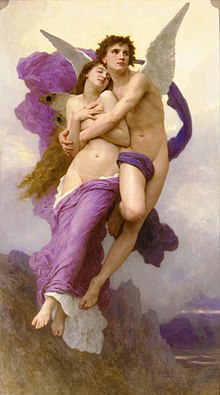
Meanwhile, Cupid's wound has healed into a scar, and he escapes his mother's house by flying out of a window. When he finds Psyche, he draws the sleep from her face and replaces it in the box, then pricks her with an arrow that does no harm. He lifts her into the air, and takes her to present the box to Venus.
He then takes his case to Zeus, who gives his consent in return for Cupid's future help whenever a choice maiden catches his eye. Zeus has Hermes convene an assembly of the gods in the theater of heaven, where he makes a public statement of approval, warns Venus to back off, and gives Psyche ambrosia, the drink of immortality,[16] so the couple can be united in marriage as equals. Their union, he says, will redeem Cupid from his history of provoking adultery and sordid liaisons.[17] Zeus's word is solemnized with a wedding banquet.
With its happy marriage and resolution of conflicts, the tale ends in the manner of classic comedy[18] or Greek romances such as Daphnis and Chloe.[19] The child born to the couple will be Voluptas (Greek Hedone ‘Ηδονή), "Pleasure".
The Wedding of Cupid and Psyche

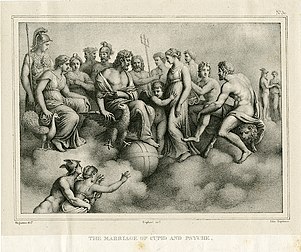
The assembly of the gods has been a popular subject for both visual and performing arts, with the wedding banquet of Cupid and Psyche a particularly rich occasion. With the wedding of
The wedding provides closure for the narrative structure as well as for the love story: the mysteriously provided pleasures Psyche enjoyed in the domus of Cupid at the beginning of her odyssey, when she entered into a false marriage preceded by funeral rites, are reimagined in the hall of the gods following correct ritual procedure for a real marriage.[20] The arranging of the gods in their proper order (in ordinem) would evoke for the Roman audience the religious ceremony of the lectisternium, a public banquet held for the major deities in the form of statues arranged on luxurious couches, as if they were present and participating in the meal.[21]
The wedding banquet was a favored theme for Renaissance art. As early as 1497,
In the 18th century, François Boucher's Marriage of Cupid and Psyche (1744) affirmed Enlightenment ideals with the authority figure Jupiter presiding over a marriage of lovely equals. The painting reflects the Rococo taste for pastels, fluid delicacy, and amorous scenarios infused with youth and beauty.[25]
As allegory
The story of Cupid and Psyche was readily allegorized. In late antiquity, Martianus Capella (5th century) refashions it as an allegory about the fall of the human soul.[27] For Apuleius, immortality is granted to the soul of Psyche as a reward for commitment to sexual love. In the version of Martianus, sexual love draws Psyche into the material world that is subject to death:[28] "Cupid takes Psyche from Virtue and shackles her in adamantine chains".[29]
The tale thus lent itself to adaptation in a Christian or
The temptation to interpret the story as a religious or philosophical allegory can still be found in modern scholarship. Psyche by her very name represents the aspirations of the human soul – towards a divine love personified in Cupid. But this misses the characterisation of Cupid as a corrupter who delights in disrupting marriages (The Golden Ass IV. 30) and is himself "notorious for his adulteries" (VI. 23), the marked sensuality of his union with Psyche (V. 13), the help Jupiter offers him if he provides a new girl for Jupiter to seduce (VI. 22) and the name given to Cupid and Psyche's child – Voluptas (Pleasure).
Classical tradition
Apuleius's novel was among the ancient texts that made the crucial transition from
One of the most popular images from the tale was Psyche's discovery of a naked Cupid sleeping, found in ceramics,

Another peak of interest in Cupid and Psyche occurred in the Paris of the late 1790s and early 1800s, reflected in a proliferation of opera, ballet,
Literature
In 1491, the poet

William Morris retold the Cupid and Psyche story in verse in The Earthly Paradise (1868–70), and a chapter in Walter Pater's Marius the Epicurean (1885) was a prose translation.[44] About the same time, Robert Bridges wrote Eros and Psyche: A Narrative Poem in Twelve Measures (1885; 1894).
Translations
Folklore and children's literature

Origins
Folklore scholarship has also occupied itself with the possible origin of the narrative.[52][53] Swedish folklorist Jan-Öjvind Swahn, who authored a long study on the story, and German philologist Ludwig Friedländer defended the idea that it originated from a legitimate folklore source.[54][55]
Some scholars tend to look for a single source: Stith Thompson suggested an Italian origin,[56] while Lesky, Gédeon Huet[57] and Georgios A. Megas indicated a Greek origin.[58] French Émile Dermenghem favoured a North African source,[59] followed by French researchers Nedjima and Emmanuel Plantade, who all argue that the tale is a reworking of Berber folklore, since Apuleius was born and lived in Madauros, Numidia, located in what is modern day Algeria.[60]
Another line of scholars argue for some myth that underlines the Apuleian narrative. German classicist Richard August Reitzenstein supposed on an "Iranian sacral myth", brought to Greece via Egypt.[61][62] Graham Anderson argues for a reworking of mythic material from Asia Minor (namely, Hittite: the Myth of Telipinu).[63] In a study published posthumously, Romanian folklorist Petru Caraman also argued for a folkloric origin, but was of the notion that Apuleius superimposed Graeco-Roman mythology on a pre-Christian myth about a serpentine or draconic husband, or a "King of Snakes" that becomes human at night.[64]
On the other extreme, German classicist Detlev Fehling took a hard and skeptical approach and considered the tale to be a literary invention of Apuleius himself.[65]
Literary legacy
Friedländer also listed several European tales of marriage between a human maiden and prince cursed to be an animal, as related to the "Cupid and Psyche" cycle of stories (which later became known as "
Thomas Bulfinch wrote a shorter adaptation of the Cupid and Psyche tale for his Age of Fable, borrowing Tighe's invention of Cupid's self-wounding, which did not appear in the original. Josephine Preston Peabody wrote a version for children in her Old Greek Folk Stories Told Anew (1897).
C. S. Lewis' Till We Have Faces is a retelling of Apuleius' Cupid and Psyche from the perspective of one of Psyche's sisters. Till We Have Faces is C. S. Lewis' last work of fiction and elaborates on Apuleius' story in a modern way.
Performing arts
In 1634,
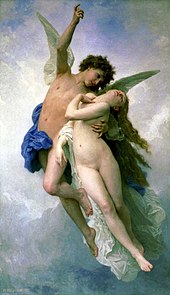
In the 19th century, Cupid and Psyche was a source for "transformations", visual interludes involving
Modern adaptations
Cupid and Psyche continues to be a source of inspiration for modern playwrights and composers. Notable adaptations include:
- Psyche (symphonic poem) by César Franck (1888)[78]
- Till We Have Faces: A Myth Retold by C. S. Lewis [79]
- "Psyché:poème dramatique en trois actes," (play) by Gabriel Mourey, Paris, Mercure de France, 1913. "Syrinx" was composed by Claude Debussy as incidental music for the play.[80]
- Eros and Psyche (opera) with libretto by Jerzy Żuławski, composed by Ludomir Różycki (Wroclaw, Poland, 1917) [81]
- ' 'Psyche: An Opera in Three Acts (opera) based on the novel Psyche by Louis Couperus, composed by Meta Overman (1955) [82][83]
- Metamorphoses (play) by Mary Zimmerman, adapted from the classic Ovid poem Metamorphoses, including the myth of Eros and Psyche (Northwestern University, 1996; Circle in the Square Theatre, Broadway, NYC 2002)
- The Golden Ass (play) by Peter Oswald, adapted from Apuleius, commissioned for Shakespeare's Globe (London, England 2002) [84]
- Cupid and Psyche (musical) by with book and lyrics by Sean Hartley and music by Jihwan Kim (New York City, NY 2003).[85]
- Cupid and Psyche (verse drama) by Joseph Fisher (Stark Raving Theatre, Portland, OR 2002; Staged Reading: Oregon Shakespeare Festival, 2002) [86]
- Amor & Psyche (pastiche opera) arranged by Alan Dornak (Opera Feroce, part of Vertical Player Repertory, New York City, 2010)[87][88]
- Cupid and Psyche: An Internet Love Story (play) by Maria Hernandez, Emma Rosecan and Alexis Stickovitch (YouthPLAYS, 2012) [89]
- Psyche: A Modern Rock Opera (rock opera) by Cindy Shapiro (Greenway Court Theater, Los Angeles, CA, 2014) [90][91]
- Cupid and Psyche (verse drama) by Emily C. A. Snyder (Turn to Flesh Productions [TTF], New York City, NY, 2014).[92] As part of the Love and Death Trilogy (Staged Reading, TTF, New York City, NY 2018) [93]
- Amor and Psyche (In Times of Plagues) (Short film) by VestAndPage (2020) [94]
- "Amore e Psiche" (electronic poem) by Fabio Mengozzi (2023)[95]
Psychology
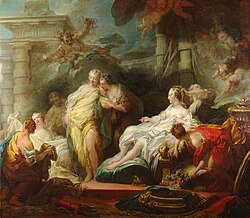
Viewed in terms of psychology rather than allegory, the tale of Cupid and Psyche shows how "a mutable person … matures within the social constructs of family and marriage".[96] In the Jungian allegory of Erich Neumann (1956), the story of Psyche was interpreted as "the psychic development of the feminine".[97][98]
Cupid and Psyche has been analyzed from a
James Hillman made the story the basis for his critique of scientific psychology, The Myth of Analysis: Three Essays in Archetypal Psychology (1983). Carol Gilligan uses the story as the basis for much of her analysis of love and relationships in The Birth of Pleasure (Knopf, 2002).
Fine and decorative arts
The story of Cupid and Psyche is depicted in a wide range of visual media. Psyche is often represented with butterfly wings, and the butterfly is her frequent attribute and a symbol of the soul, though the literary Cupid and Psyche never says that she has or acquires wings. In antiquity, an iconographical tradition existed independently of Apuleius's tale and influenced later depictions.[101]
Ancient art


Some extant examples suggest that in antiquity Cupid and Psyche could have a religious or mystical meaning. Rings bearing their likeness, several of which come from Roman Britain, may have served an amuletic purpose.[106] Engraved gems from Britain represent spiritual torment with the image of Cupid torching a butterfly.[107] The two are also depicted in high relief in mass-produced Roman domestic plaster wares from the 1st to 2nd centuries AD found in excavations at Greco-Bactrian merchant settlements on the ancient Silk Road at Begram in Afghanistan[108] (see gallery below). The allegorical pairing depicts perfection of human love in integrated embrace of body and soul ('psyche' Greek for butterfly symbol for transcendent immortal life after death). On sarcophagi, the couple often seem to represent an allegory of love overcoming death.[6]
A relief of Cupid and Psyche was displayed at the
In late antiquity, the couple are often shown in a "chin-chuck" embrace, a gesture of "erotic communion" with a long history.[110] The rediscovery of freestanding sculptures of the couple influenced several significant works of the modern era.
Other depictions surviving from antiquity include a 2nd-century
Modern era
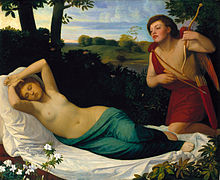
Works of art proliferated after the rediscovery of Apuleius's text, in conjunction with the influence of classical sculpture. In the mid-15th century, Cupid and Psyche became a popular subject for Italian wedding chests (
Cupid and Psyche is a rich source for scenarios, and several artists have produced cycles of works based on it, including the frescoes at the
The special interest in the wedding as a subject in Northern Mannerism seems to spring from a large
The most popular subjects for single paintings or sculpture are the couple alone, or explorations of the figure of Psyche, who is sometimes depicted in compositions that recall the sleeping
Portrayals of Psyche alone are often not confined to illustrating a scene from Apuleius, but may draw on the broader Platonic tradition in which Love was a force that shaped the self. The Psyche Abandoned of
Sculpture
Source:[124]
-
Cupid and Psyche(from an original of 2nd century BC)
-
Cupid and Psyche (c. 150 AD)
-
Psyche Revived by Cupid's Kiss (1793) by Antonio Canova, Louvre
-
Cupid and Psyche byClodion(d. 1814)
-
Psyche by Bertel Thorvaldsen (d. 1844)
Paintings
-
Amor and Psyche (1589) by Jacopo Zucchi
-
Cupid and Psyche (1639–40) by Anthony van Dyck: Cupid finds the sleeping Psyche.
-
Amor and Psyche (1767) by Louis-Jean-François Lagrenée
-
Cupid and Psyche in the nuptial bower (1792-93) by Hugh Douglas Hamilton
-
Allegory of Love, Cupid and Psyche (between 1798 and 1805) by Goya
-
Psyche Lifted Up by Zephyrs (Romantic, c. 1800) by Pierre-Paul Prud'hon
-
Cupid and Psyche (1808) byPRA
-
Psyche Abandoned (c. 1817) by François-Édouard Picot
-
Cupid and Psyche (1843) by Jean-Pierre Saint-Ours
-
Cupid and Psyche (1843) by William Page
-
Cupid and Psyche (1850–55) by Károly Brocky
-
Cupid Flying Away from Psyche (between 1872 and 1881) by Edward Burne-Jones
-
Psyche Receiving the Casket Back (between 1872 and 1881) by Edward Burne-Jones
-
Psyche (1890) by John Reinhard Weguelin
-
Cupid and Psyche (1891) by Annie Swynnerton
-
Psyche Opening the Golden Box (1903) by John William Waterhouse
-
Cupid and Psyche (1907) by Edvard Munch
See also
- Beauty and the Beast – French fairy tale
- East of the Sun and West of the Moon – Norwegian fairy tale
- Graciosa and Percinet – French literary fairy tale written by Madame d'Aulnoy
- Pride and Prejudice
- Snow-White and Rose-Red – German fairy tale
- Tulisa, the Wood-Cutter's Daughter (Indian tale)
References
- ^ Dorothy Johnson, David to Delacroix: The Rise of Romantic Mythology (University of North Carolina Press, 2011), pp. 81–87.
- ISBN 0156904365.
- ^ Stephen Harrison, entry on "Cupid," The Oxford Encyclopedia of Ancient Greece and Rome (Oxford University Press, 2010), p. 338.
- ISBN 9789004296688.
- ^ Harrison, "Cupid and Psyche," in Oxford Encyclopedia of Ancient Greece and Rome, p. 339.
- ^ a b c d Harrison, "Cupid and Psyche," Oxford Encyclopedia of Ancient Greece and Rome, p. 338.
- ^ Entry on "Apuleius", in The Classical Tradition (Harvard University Press, 2010), pp. 56–57.
- ^ E.J. Kenney, Apuleius: Cupid and Psyche (Cambridge University Press, 1990), pp. 22–23
- ProQuest 1299144271.
- ^ Jane Kingsley-Smith, Cupid in Early Modern Literature and Culture (Cambridge University Press, 2010), p. 164.
- ^ The following summary is condensed from the translation of Kenney (Cambridge University Press, 1990), and the revised translation of W. Adlington by S. Gaseless for the Loeb Classical Library (Harvard University Press, 1915), with reference to the accompanying Latin text.
- ^ Papaioannou, "Charite's Rape, Psyche on the Rock," p. 319.
- ^ Max Nelson, "Narcissus: Myth and Magic," Classical Journal 95.4 (2000), p. 364, citing S. Lancel, "Curiositas et préoccupations spirituelles chez Apulée," Revue de l'histoire des religions 160 (1961), pp. 41–45.
- ^ By the 6th-century mythographer Fulgentius; Joel C. Relihan, Apuleius: The Tale of Cupid and Psyche (Hackett, 2009), p. 65.
- ^ Cakes were often offerings to the gods, particularly in Eleusinian religion; cakes of barley meal moistened with honey, called prokonia (προκώνια), were offered to Demeter and Kore at the time of first harvest. See Allaire Brumfield, “Cakes in the liknon: Votives from the Sanctuary of Demeter and Kore on Acrocorinth,” Hesperia 66 (1997) 147–172.
- ^ Apuleius describes it as served in a cup, though ambrosia is usually regarded as a food and nectar as a drink.
- ^ Philip Hardie, Rumour and Renown: Representations of Fama in Western Literature (Cambridge University Press, 2012), p. 116; Papaioannou, "Charite's Rape, Psyche on the Rock," p. 321.
- ^ Relihan, The Tale of Cupid and Psyche, p. 79.
- ^ Stephen Harrison, "Divine Authority in 'Cupid and Psyche': Apuleius Metamorphoses 6,23–24," in Ancient Narrative: Authors, Authority, and Interpreters in the Ancient Novel. Essays in Honor of Gareth L. Schmeling (Barkhuis, 2006), p. 182.
- ^ Harrison, "Divine Authority in 'Cupid and Psyche'," p. 179.
- ^ a b Harrison, "Divine Authority in 'Cupid and Psyche'," p. 182.
- ^ Ariane van Suchtelen and Anne T. Woollett, Rubens and Brueghel: A Working Friendship (Getty Publications, 2006), p. 60; Susan Maxwell, The Court Art of Friedrich Sustris: Patronage in Late Renaissance Bavaria (Ashgate, 2011), pp. 172, 174.
- ^ Van Suchtelen and Woollett, Rubens and Brueghel, p. 60; Maxwell, The Court Art of Friedrich Sustris, p. 172.
- ^ Martha Hollander, An Entrance for the Eyes: Space and Meaning in Seventeenth-Century Dutch Art (University of California Press, 2002), pp. 11–12.
- ^ Michelle Facos, An Introduction to 19th Century Art (Routledge, 2011), p. 20.
- Biblioteca Apostolica Vaticana.
- ^ Danuta Shanzer, A Philosophical and Literary Commentary on Martianus Capella's De Nuptiis Philologiae et Mercurii Book 1 (University of California Press, 1986), p. 69.
- ^ Relihan, The Tale of Cupid and Psyche, p. 59.
- ^ Martianus Capella, De Nuptiis 7; Chance, Medieval Mythography, p. 271.
- ISBN 978-88-8265-722-2.
- ^ Patricia Cox Miller, "'The Little Blue Flower Is Red': Relics and the Poeticizing of the Body," Journal of Early Christian Studies 8.2 (2000), p. 229.
- ^ a b Entry on "Apuleius," Classical Tradition, p. 56.
- ^ Relihan, The Tale of Cupid and Psyche, p. 64.
- ^ Robert H.F. Carver, "The Rediscovery of the Latin Novels," in Latin Fiction: The Latin Novel in Context (Routledge, 1999), p. 257; Regine May, "The Prologue to Apuleius' Metamorphoses and Coluccio Salutati: MS Harley 4838," in Ancient Narrative. Lectiones Scrupulosae: Essays on the Text and Interpretation of Apuleius' Metamorphoses in Honour of Maaike Zimmerman (Barkhuis, 2006), p. 282.
- ^ Carver, "The Rediscovery of the Latin Novels," p. 259.
- ^ May, "The Prologue to Apuleius' Metamorphoses," pp. 282–284.
- ^ Jane Kingsley-Smith, Cupid in Early Modern Literature and Culture (Cambridge University Press, 2010), pp. 11, 165.
- ^ a b Kingsley-Smith, Cupid in Early Modern Literature and Culture, p. 168.
- ^ Kingsley-Smith, Cupid in Early Modern Literature and Culture, pp. 163, 168. The fresco cycle, commissioned by Sir Thomas Smith, was based on engravings by the Master of the Die and Agostino Veneziano (1536), which had been taken from the work of Michiel Coxie that was modeled on the Loggia di Psiche.
- ^ Kingsley-Smith, Cupid in Early Modern Literature and Culture, p. 173.
- ^ Kingsley-Smith, Cupid in Early Modern Literature and Culture, p. 176.
- ^ Ewa Lajer-Burchart, Necklines: The Art of Jacques-Louis David After the Terror (Yale University Press, 1999), pp. 278–279.
- ^ Kathleen Raine, Blake and Tradition (Routledge, 1969, 2002), vol. 1, p. 183.
- ^ a b c Entry on "Apuleius," Classical Tradition, p. 57.
- A Vision of the Last Judgment, and especially pp. 183, 191 and 201.
- ^ As described by a contemporary reviewer of the new work, quoted by Philippe Bordes, Jacques-Louis David: Empire to Exile (Yale University Press, 2005), p. 234.
- ^ Bordes, Jacques-Louis David, p. 232.
- ^ Keats, John (15 August 2021). "Ode To Psyche". Poetry Foundation.
- ^ J. Lawrence Mitchell, "Ray Garnett as Illustrator". Powys Review 10 (spring 1982), pp. 9–28.
- ^ Entry on "Apuleius," Classical Tradition, p. 57.
- ^ Raine, Blake and Tradition, vol. 1, p. 182.
- ^ Walsh, Patrick G. The Roman novel: The 'Satyricon' of Petronius and the 'Metamorphoses' of Apuleius. Cambridge: Cambridge University Press, 1970. pp. 193-195.
- S2CID 192357521.
- .
- ^ Friedländer, Ludwig. Roman life and manners under the early Empire. Vol. IV. London: Routledge. 1913. p. 102.
- ISBN 0-520-03537-2.
The tale [of Cupid and Psyche] has most of the elements of the present-day folk story (...) we have here what certainly appears to be a real tale of the Italian countryside during the reign of Marcus Aurelius
- ^ Huet, Gedeon Busken (1923). Contes populaires (in French). Paris: E. Flammarion. p. 43.
Nous possêdons encore, dans l'histoire de Psyche, inserée par Apulee dans son roman des Metamorphoses, un vrai conte populaire de l'antiquité ...
- ^ Megas, G. 1967. Das Märchen von Amor und Psyche in der griechischen Volksüberlieferung (AaTh 425, 428 & 432). Athens
- JSTOR 41518077.
- ^ Plantade, Emmanuel and Nedjima. "Libyca Psyche: Apuleius and the Berber Folktales". In: Apuleius and Africa. Editors: Benjamin Todd Lee, Luca Graverini, Ellen Finkelpearl. Routledge, 2014. pp. 174-202.
- ^ Reitzenstein, Richard. Das märchen von Amor und Psyche bei Apuleius. Leipzig: B.G. Teubner. 1912.
- ISBN 90-04-06195-9.
- ISBN 978-0-415-23702-4.
- ^ Repciuc, Ioana. "Identificarea sursei folclorice a basmului Cupidon şi Psyché de către Petru Caraman – în contextul cercetărilor internaţionale" [Petru Caraman's Work on Identifying the Folkloric Source of Cupidon şi Psyche Fairytale – In the Context of International Research]. In: Anuarul Muzeului Etnografic al Moldovei 15 (2015): 193, 197-205.
- .
- ^ Friedländer, Ludwig. Roman life and manners under the early Empire. Vol. IV. London: Routledge. 1913. pp. 88-123.
- .
- ^ Harrison, "Cupid and Psyche," Oxford Encyclopedia of Ancient Greece and Rome, p. 339.
- ^ Amy K. Levin, The Suppressed Sister: A Relationship in Novels by Nineteenth- and Twentieth-Century British Women (Associated University Presses, 1992), pp. 23–24 et passim.
- ^ Entry on "Apuleius", Classical Tradition, p. 57.
- ^ Anita Callaway, Visual Ephemera: Theatrical Art in Nineteenth-Century Australia (University of New South Wales Press, 2000), p. 177.
- ^ Charles Musser, "Comparison and Judgment across Theater, Film, and the Visual Arts during the Late Nineteenth Century," in Moving Pictures: American Art and Early Film, 1880-1910 (Hudson Hills Press for Williams College Museum of Art, 2005), pp. 6–7; pp. 73–74.
- ^ a b Callaway, Visual Ephemera, p. 76.
- ^ Musser, "Comparison and Judgment across Theater, Film, and the Visual Arts," p. 7.
- ^ Callaway, Visual Ephemera, p. 217.
- ^ Callaway, Visual Ephemera, p. 70
- ^ Arnold Haskell (ed) 'Gala Performance' (Collins 1955) p213.
- ^ Tommasini, Anthony (5 October 1997). "CLASSICAL MUSIC; Spelling Out The Musical Tale of 'Psyche'". The New York Times.
- ^ "Till We Have Faces | Fantasy Novel, Mythology & Christian Allegory | Britannica". www.britannica.com. Retrieved 2023-11-02.
- ^ "Debussy's Syrinx: mystery, myth, and a manuscript - Document - Gale Academic OneFile".
- ^ Nine, Keris (2018-05-15). "OperaJournal: Różycki - Eros and Psyche (Warsaw, 2017)". OperaJournal. Retrieved 2019-12-06.
- ^ "Psyche - An opera in 3 acts by Meta Overman". www.facebook.com. Retrieved 2019-12-06.
- ^ "Meta Overman's opera Psyche revived". Limelight. Retrieved 2019-12-06.
- ISSN 0261-3077. Retrieved 2019-12-06.
- ^ "Cupid and Psyche | TheaterMania". www.theatermania.com. Retrieved 2019-12-06.
- ^ "Cupid & Psyche by Joseph Fisher | Playscripts Inc". www.playscripts.com. Retrieved 2019-12-06.
- ^ Schweitzer, Vivien (25 October 2010). "Variety Show, With Arias Thrown In". The New York Times.
- ^ "Repertoire". Opera Feroce. Retrieved 2019-12-06.
- ^ "Cupid and Psyche: An Internet Love Story by Maria Hernandez, Emma Rosecan, and Alexis Stickovitch". YouthPLAYS. Retrieved 2019-12-06.
- ^ Fresh, Opera (2014-09-03). "Opera Fresh: Rock Opera Offers New Telling Of The Psyche And Eros Story". Opera Fresh. Retrieved 2019-12-06.
- ^ "Psyche Rock Opera". psycherockopera. Retrieved 2019-12-06.
- ^ "Review: Cupid and Psyche". StageBuddy.com. 2014-03-06. Retrieved 2019-12-06.
- ^ BWW News Desk. "Turn to Flesh Productions Celebrates Five Years". BroadwayWorld.com. Retrieved 2019-12-06.
- ^ "Review: Amor and Psyche". pixelsgarage.com. 2020-11-26. Retrieved 2020-11-27.
- ^ "Opere - Amore e Psiche". il Saxofono italiano (in Italian).
- ^ Relihan, The Tale of Cupid and Psyche, p. 76.
- ^ , entry on "Apuleius," Classical Tradition, p. 56.
- ^ Neumann, Erich. Amor and Psyche: The psychic development of the feminine. Vol. 24. Routledge, 2013
- ^ Amy K. Levin, The Suppressed Sister: A Relationship in Novels by Nineteenth- and Twentieth-Century British Women (Associated University Presses, 1992), p. 22.
- ^ Levin, The Suppressed Sister, p. 14.
- ^ Relihan, The Tale of Cupid and Psyche, p. xvii; Jean Sorabella, "A Roman Sarcophagus and Its Patron," Metropolitan Museum Journal 36 (2001), p. 73.
- ^ "Sarcophagus panel: Cupid and Psyche", Indianapolis Museum of Art description. Archived 2012-06-22 at the Wayback Machine The sarcophagus was made for retail, and the portrait added later.
- ISBN 9781426202957. Retrieved 20 March 2018 – via Google Books.
- ^ "Lost Treasures From the National Museum, Afghanistan, Exhibitions, Photos, Information -- National Geographic". National Geographic Society. Archived from the original on 2008-04-22.
- ^ "Looted Afghan treasures identified". independent.co.uk. 1 March 2011. Retrieved 20 March 2018.
- ^ Jean Bagnall Smith, "Votive Objects and Objects of Votive Significance from Great Walsingham," Britannia 30 (1999), p. 36.
- ^ Dominic Perring, "'Gnosticism' in Fourth-Century Britain: The Frampton Mosaics Reconsidered," Britannia 34 (2003), p. 119, citing also M. Henig, "Death and the Maiden: Funerary Symbolism in Daily Life," in Roman Life and Art in Britain, British Archaeological Reports 41 (Oxford, 1977).
- ^ "Audio slide show, online at "Hidden Treasures of Afghanistan," website hosted by National Geographic for US venue of travelling exhibit". Nationalgeographic.com. 2002-10-17. Archived from the original on April 22, 2008. Retrieved 2013-10-06.
- ^ R.L. Gordon, "Franz Cumont and the Doctrines of Mithraism," in Mithraic Studies (Manchester University Press, 1975), p. 239.
- ^ Leo Steinberg, The Sexuality of Christ in Renaissance Art and in Modern Oblivion (University of Chicago Press, 1983, 2nd ed. 1996), p. 5.
- ^ Gaisser, The Fortunes of Apuleius and The Golden Ass, p. 20.
- ^ a b Entry on "Apuleius," Classical Tradition, p. 57.
- ^ According to Maria Grazia Pernis and Laurie Schneider Adams, Lucrezia Tornabuoni De' Medici and the Medici Family in the Fifteenth Century (Peter Lang, 2006), p. 24, the Medici family commissioned a pair illustrating the tale for the wedding of Lucrezia Tornabuoni and Piero di Cosimo de' Medici in 1444, owing perhaps to the appeal of Boccaccio's allegory to the intellectual but devout Piero. Other scholars hold the same view, but 1470 is perhaps the more widely accepted date. See Julia Haig Gaisser, The Fortunes of Apuleius and The Golden Ass: A Study in Transmission and Reception (Princeton University Press, 2008), p. 119, especially note 193 for further sources. In that case, the chests were created for the wedding of Lorenzo de' Medici, Piero's son, and Clarice Orsini.
- ^ Gaisser, The Fortunes of Apuleius, p. 119.
- ^ Bull, pp. 342-343
- ^ Vera Schuster, "The Pre-Raphaelites in Oxford," Oxford Art Journal 1 (1978), p. 7.
- ^ J. Kirk T. Varnedoe with Elizabeth Streicher, Graphic Works of Max Klinger (Dover, 1977), p. 78.
- ^ The engraving at the Metropolitan Museum of Art; at the British Museum, in sections; Bull, 342–343
- ^ Marion Lawrence, "Ships, Monsters and Jonah," American Journal of Archaeology 66.3 (1962), p. 290.
- ^ John D'Emilio and Estelle B. Freedman, Intimate Matters: A History of Sexuality in America (University of Chicago Press, 1988, 1997), 2nd ed., pp. 108, 148.
- ^ Alison Smith, The Victorian Nude: Sexuality, Morality, and Art (Manchester University Press, 1996), p. 120.
- ^ Smith, The Victorian Nude, pp. 71–72.
- ^ Ewa Lajer-Burchart, Necklines: The Art of Jacques-Louis David After the Terror (Yale University Press, 1999), p. 54ff., especially p. 61.
- ^ "Eros and Psyche 1st century BCE from Pella,..." museumofclassicalantiquities. Retrieved 20 March 2018.
Sources
- Malcolm Bull, The Mirror of the Gods, How Renaissance Artists Rediscovered the Pagan Gods, pp. 342–343, Oxford UP, 2005, ISBN 978-0195219234
- Anita Callaway, Visual Ephemera: Theatrical Art in Nineteenth-Century Australia (University of New South Wales Press, 2000)
- Harrison, Stephen (2006). "Divine Authority in 'Cupid and Psyche': Apuleius Metamorphoses 6,23–24". In Schmeling, Gareth L. (ed.). Authors, Authority and Interpreters in the Ancient Novel: Essays in Honor of Gareth L. Schmeling. Barkhuis. pp. 172–185. ISBN 978-90-77922-13-2.
Further reading
- Belmont, Nicole (1991). "La tâche de Psyché". Ethnologie française. 21 (4): 386–391. JSTOR 40989292.
- Benson, Geoffrey C. (2018). "Cupid and Psyche and the Illumination of the Unseen". In Cueva, Edmund; Harrison, Stephen; Mason, Hugh; Owens, William; Schwartz, Saundra (eds.). Re-Wiring The Ancient Novel, 2 Volume set: Volume 1: Greek Novels, Volume 2: Roman Novels and Other Important Texts. Vol. 24. Barkhuis. pp. 85–116. JSTOR j.ctvggx289.30.
- Bonilla y San Martin, Adolfo. El mito de Psyquis: un cuento de niños, una tradición simbólica y un estudio sobre el problema fundamental de la filosofía. Barcelona: Imprenta de Henrich y Cia. 1908.
- Edwards, Lee R. (1979). "The Labors of Psyche: Toward a Theory of Female Heroism". Critical Inquiry. 6 (1): 33–49. S2CID 162110603.
- Edwards, M. J. (1992). "The Tale of Cupid and Psyche". Zeitschrift für Papyrologie und Epigraphik. 94: 77–94. JSTOR 20188784.
- Felton, D. (1 October 2013). "Apuleius' Cupid Considered as a Lamia ( Metamorphoses 5.17-18)". Illinois Classical Studies. 38: 229–244. .
- Gaisser, Julia Haig (2017). "Cupid and Psyche". A Handbook to the Reception of Classical Mythology. pp. 337–351. ISBN 9781119072034.
- E. J. Kenney (Ed.), Apuleius. Cupid and Psyche -Cambridge Greek and Latin Classics. Cambridge University Press. 1990. ISBN 0-521-26038-8.
- Morwood, James (2010). "Cupid Grows Up". Greece & Rome. 57 (1): 107–116. S2CID 162521335.
- Purser, Louis Claude. The Story of Cupid and Psyche as related by Apuleius. London: George Bell and Sons. 1910. pp. xlvii-li.
- Tommasi Moreschini, Chiara O.. "Gnostic Variations on the Tale of Cupid and Psyche". In: Intende, Lector - Echoes of Myth, Religion and Ritual in the Ancient Novel. Edited by Marília P. Futre Pinheiro, Anton Bierl and Roger Beck. Berlin, Boston: De Gruyter, 2013. pp. 123-144. https://doi.org/10.1515/9783110311907.123
- Vertova, Luisa (1 January 1979). "Cupid and Psyche in Renaissance Painting before Raphael". Journal of the Warburg and Courtauld Institutes. 42 (1): 104–121. S2CID 195046803.
- Zimmermann, Martin et al. (Ed.). Aspects of Apuleius' Golden Ass. Volume II. Cupid and Psyche. Groningen, Egbert Forsten. 1998. ISBN 90-6980-121-3.
Folkloristic analysis:
- JSTOR 41389987.
- Caraman, Petru. "Identificarea episodului despre Cupidon şi Psyche, din romanul „Metamorphoses” al lui Apuleius, cu un basm autentic popular" [Identification of the Episode on Cupidon and Psyche, in the Novel Metamorphoses by Appuleius, with An Authentic Folk Fairy Tale]. In: Anuarul Muzeului Etnografic al Moldovei 9 (2009): 11–85.
- Herrmann, Léon. "Légendes locales et thèmes littéraires dans le conte de Psyché". In: L'antiquité classique, Bruxelles, tome 21, fasc. 1, 1952, pp. 13-27.
- Hood, Gwenyth. “Husbands and Gods as Shadowbrutes: Beauty and the Beast from Apuleius to C. S. Lewis”. In: Mythlore 56 Winter (1988): pp. 33–60.
- Hurbánková, Šárka (2018). "G.B. Basile and Apuleius: first literary tales : morphological analysis of three fairytales". Graeco-Latina Brunensia (2): 75–93. .
- Jacobs, Joseph. European Folk and Fairy Tales. New York, London: G. P. Putnam's sons. 1916. pp. 246–249.
- Perencin, Nicola (2020). "Le nozze funebri di Psiche - Apuleio, Met. IV 33-34 alla luce del folklore romeno". Lingua. Language and Culture. XIX (1): 89–112.
- Plantade, Emmanuel et Nedjima. «Du conte berbère au mythe grec: le cas d'Éros et Psyché». In: Revue des Études Berbères no 9, 2013, pp. 533–563.
- Plantade, Emmanuel (2023). Le conte de Psyché et Cupidon, témoin du folklore d’Afrique du nord: essai sur la poétique transculturelle d’Apulée (in French). Hildesheim Zürich New York: Georg Olms Verlag. ISBN 9783487164137.
- Reider (2015). "A Demon in the Sky: The Tale of Amewakahiko, a Japanese Medieval Story". Marvels & Tales. 29 (2): 265. S2CID 161774066.
- Repciuc, Ioana. "Identificarea sursei folclorice a basmului Cupidon şi Psyché de către Petru Caraman – în contextul cercetărilor internaţionale" [Petru Caraman's Work on Identifying the Folkloric Source of Cupidon şi Psyche Fairytale – In the Context of International Research]. In: Anuarul Muzeului Etnografic al Moldovei 15 (2015): 187–205.
- Swahn, Jan-Ojvind. The Tale of Cupid and Psyche. Lund, C. W. Κ. Gleerup, s. d. (1955).
- Wright, James R. G. (1971). "Folk-Tale and Literary Technique in Cupid and Psyche". The Classical Quarterly. 21 (1): 273–284. S2CID 170565870.
External links
- Tales Similar to Beauty and the Beast (Texts of Cupid and Psyche and similar monster or beast as bridegroom tales, mostly of AT-425C form, with hyperlinked commentary).
- Robert Bridges' Eros and Psyche at archive.org: PDF or read online
- Mary Tighe, Psyche or, the Legend of Love (1820) HTML or PDF
 "Cupid and Psyche". A poem by Letitia Elizabeth Landon from The Literary Souvenir, 1827.
"Cupid and Psyche". A poem by Letitia Elizabeth Landon from The Literary Souvenir, 1827.- Walter Pater, Marius the Epicurean, chapter 5 (1885)
- Thomas Bulfinch, The Age of Fable (1913)
- Hermetic Philosophy: Cupid and Psyche (Illustrated with painting and sculpture.)
- Cupid and Psyche: A New Play in Blank Verse
- Turn to Flesh Productions
Art
- Art Renewal Center: "Cupid & Psyche" by Sharrell E. Gibson (Examples and discussion of Cupid and Psyche in painting.)
- Warburg Institute Iconographic Database (c. 470 images of Cupid and Psyche)
- Tale of Cupid and Psyche engravings by Maestro del Dado and Agostino Veneziano from the De Verda collection



















